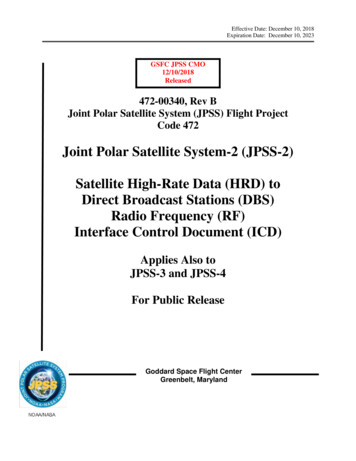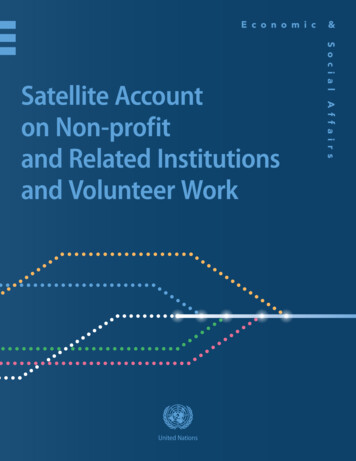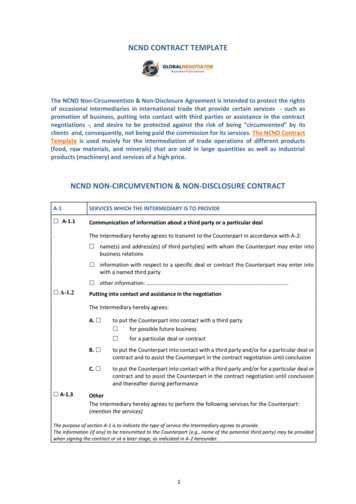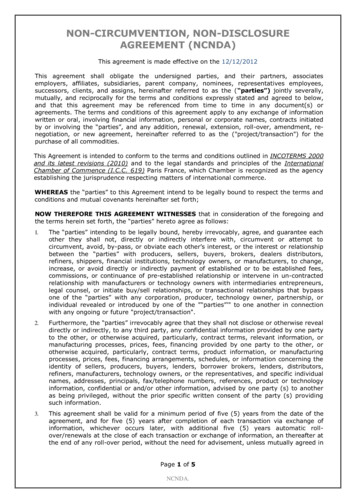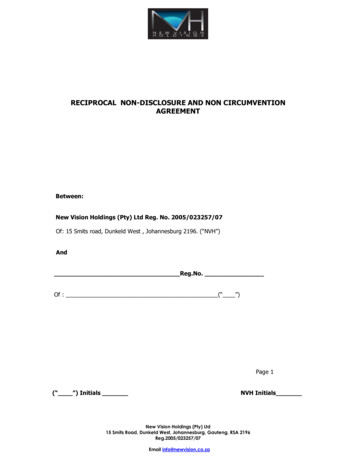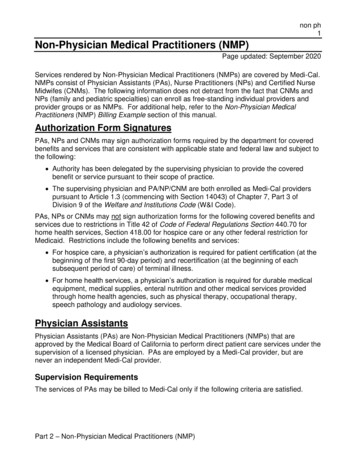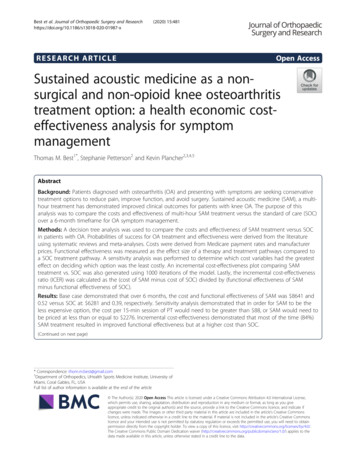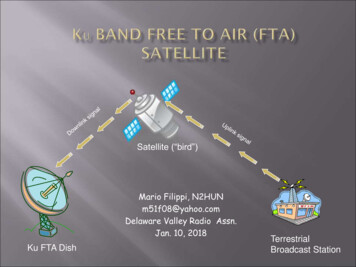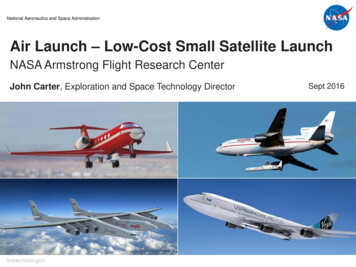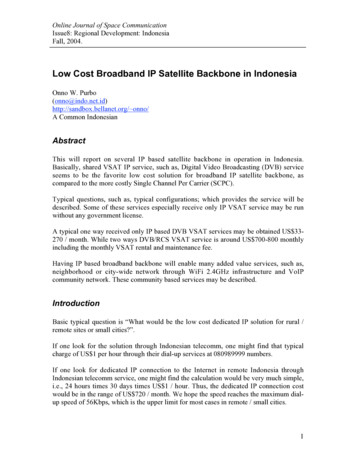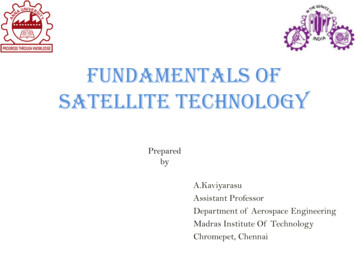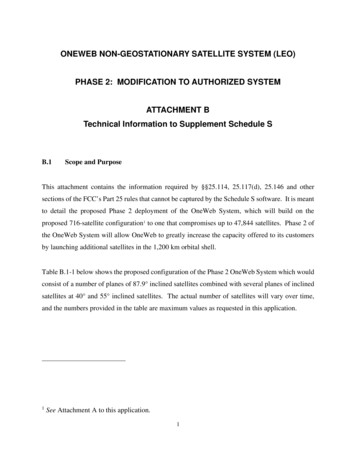
Transcription
ONEWEB NON-GEOSTATIONARY SATELLITE SYSTEM (LEO)PHASE 2: MODIFICATION TO AUTHORIZED SYSTEMATTACHMENT BTechnical Information to Supplement Schedule SB.1Scope and PurposeThis attachment contains the information required by §§25.114, 25.117(d), 25.146 and othersections of the FCC’s Part 25 rules that cannot be captured by the Schedule S software. It is meantto detail the proposed Phase 2 deployment of the OneWeb System, which will build on theproposed 716-satellite configuration1 to one that compromises up to 47,844 satellites. Phase 2 ofthe OneWeb System will allow OneWeb to greatly increase the capacity offered to its customersby launching additional satellites in the 1,200 km orbital shell.Table B.1-1 below shows the proposed configuration of the Phase 2 OneWeb System which wouldconsist of a number of planes of 87.9 inclined satellites combined with several planes of inclinedsatellites at 40 and 55 inclined satellites. The actual number of satellites will vary over time,and the numbers provided in the table are maximum values as requested in this application.1See Attachment A to this application.1
Table B.1-1: Orbital Characteristics of the OneWeb Phase 2 non-GSO satellite systemInclinationMaximum total fororbit shell4987.9 17643272040 23 0403272055 23 040Max. Number ofPlanesMax. Number ofsatellites per plane36The Schedule S associated with this application also includes data related to the Phase 1implementation of the OneWeb System, which is described in Attachment A. Certain data in theSchedule S is common to both Phase 1 and Phase 2, with the exception of the following: Orbit details in the Schedule S relate only to Phase 1 as it is not feasible to enter manuallythe large number of satellite phase angles required for Phase 2 into the online Schedule Ssoftware. The required orbit details for Phase 2 is being provided to the Commission inthe form of a separate Excel spreadsheet that is attached to this application which isstructured in the same way as the Schedule S format for orbit data; Certain satellite beams contained in the Schedule S are associated only with satellites inPhase 1 or Phase 2. This is clarified in Section A.3 of Attachment A and Section B.3 ofAttachment B.2
B.2OVERALL DESCRIPTION OF SYSTEM FACILITIES, OPERATIONS ANDSERVICES AND EXPLANATION OF HOW UPLINK FREQUENCY BANDSARE CONNECTED TO DOWNLINK FREQUENCY BANDS(§25.114(d)(1))The Phase 2 OneWeb System consists of a constellation of up to 47,844 low-Earth orbit (“LEO”)satellites, plus in-orbit spares, in a combination of three circular orbits of altitude around 1,200km, as well as associated ground control facilities, gateway earth stations and end user earthstations (“user terminals”). The Phase 2 OneWeb System will enhance the capability to providehigh-quality, broadband Internet access to small low-cost user terminals located anywhere on Earthwith greatly increased overall system capacity. The services that will be provided by the Phase 2configuration will be comparable to the broadband terrestrial services available in denselypopulated areas in the United States today. In addition, because the OneWeb satellites are at amuch lower altitude than GSO satellites, users of the OneWeb System will experience round triplatency of less than 50 milliseconds, which is approximately 1/13th of the latency of GSO satellites,and comparable to terrestrial networks.The OneWeb System uses Ku-band for the RF links between the satellites and user terminals andKa-band for the RF links between the satellites and gateway earth stations, with the latter providingthe interconnection to the global Internet backbone. The OneWeb Ku-band user terminals consistof small and inexpensive antennas (typically in the 30 cm to 1-m range). The Phase 2 deploymentwill be comprised of low-cost phased array designs, or other beam steering technology which arealready under development. An optional built-in solar array panel can be added to battery poweredterminals. The user terminals will therefore be quick and easy to deploy and can easily be usedfor transportable and mobile applications. Larger user terminals may also be employed in somesituations such as for enterprise applications with different service requirements. The Ka-bandgateway earth stations in the OneWeb System will typically utilize antennas in the 2.4 m to 3.5 m3
range, 2 depending on their location and the associated propagation characteristics and servicerequirements. Each satellite will be equipped with at least two gateway servicing antennas, whichcan simultaneously communicate with the servicing gateway site(s), and an additional antenna forhandovers.The frequency ranges used by the OneWeb system are summarized in Table B.2-1 below, aspreviously shown in relevant figures of the OneWeb Market Access Petition together with anindication of the FCC frequency allocations that exists in these bands. 3 The detailed channelizedfrequency plan is given in the associated Schedule S.Table B.2-1: Frequency bands used by the OneWeb Phase 2 DeploymentType of Link and Transmission DirectionFrequency RangesGateway-to-Satellite27.5 – 29.1 GHz29.1 – 29.5 GHz (Note 1)29.5 – 30.0 GHzSatellite-to-Gateway17.8 – 18.6 GHz18.8 – 19.3 GHz19.3 – 19.7 GHz (Note 1)19.7 – 20.2 GHz (Note 1)User Terminal-to-Satellite12.75 – 13.25 GHz (Note 1)14.0 – 14.5 GHzSatellite-to-User Terminal10.7 – 12.7 GHzNote 1: Although the OneWeb satellites have the capability to operate in the Earth-to-space direction in the 12.7513.25 GHz and the 29.1-29.5 GHz bands, and the space-to-Earth direction in the 19.3-19.7 and 19.7-20.2GHz bands, FCC authorization is not being requested for these bands at this time.2The Phase 1 OneWeb System operates with Gateway antennas that are 3.5 m in size, but thePhase 2 system with its reconfigurable beam technology could accommodate smaller gatewayantennas.3See IBFS File No. SAT-LOI-20160428-00041 (Call Sign S2963).4
The constellation of OneWeb satellites will be deployed as follows. Shortly after, or even duringthe completion of the OneWeb Phase 1 deployment, OneWeb will start to launch a small numberof Phase 2 satellites for evaluation and proof-of-concept. OneWeb plans to launch subsequentsatellites for each orbital plane in one orbit inclination, 4 and subsequently additional launches inthe same plane and/or adjacent planes until the desired coverage is attained. There is currently nopredetermined schedule for the actual number of planes in one orbital shell, nor for the number ofsatellites per plane that would be deployed before proceeding with the next orbital shell. Thereason is that service can be improved or migrated from Phase 1 constellation to the Phase 2deployment over time, as the Phase 2 satellites become available. Depending on commercialrequirements at the time, OneWeb could select any of the three proposed orbital inclinations andany of the plane RAAN and satellite spacing that would best accommodate its requirements.OneWeb will notify the Commission, consistent with §25.118(f), of the spare and active satelliteconfiguration as deployment progresses.The OneWeb System provides broadband communications services between the user terminalsand the gateway earth stations connected to the global Internet backbone. Similar, to the Phase 1configuration, several gateway earth station antennas will be collocated at a gateway site in orderto access a number of visible OneWeb satellites simultaneously from that location. It is expectedthat the full deployment would require additional antennas at each gateway earth station site to bedeployed over time worldwide – the exact number will depend on service characteristics andmarket conditions in various areas of the world. At least five gateway earth station sites areexpected to be deployed in the USA, including gateway earth stations in Hawaii and Alaska, and4Depending on the health of the Phase 1 satellites, OneWeb may choose to start Phase 2 bypopulating the 87.9 orbital shell, or any of the other two shells (40 or 55 ), however, this willultimately depend on market requirements.5
other gateway locations that have been subject of license applications in the past few years. 5 Theexact locations of any additional gateway earth stations have yet to be determined, but will buildon the initial network of existing earth stations. The gateway earth stations will also transmit andreceive control channels for purposes of satellite payload control and gateway link power control.A subset of the gateway sites in high latitude regions of the world will also act as TT&C earthstations. None of the TT&C stations are currently planned to be located in United States.OneWeb will continue to operate at least two separate satellite control centers each backing up theother. The centers, along with network operation centers, are located in Tysons, Virginia and theUnited Kingdom. Connectivity between these control centers and the TT&C and gateway earthstations has been implemented using terrestrial leased circuits and secure Internet virtual privatenetworks.Each OneWeb satellite will have 32 nominally identical user beams, operating in Ku-band, eachconsisting of a steerable spot beam. There are at least two identical steerable gateway beamantennas, operating in Ka-band, on each OneWeb satellite, and each of these antennas creates anindependently steerable circular spot beam. There is at least one beam providing connectivity witha gateway earth station and one additional gateway beam tracking the next gateway earth stationfor handover procedures.For TT&C purposes, including the control of the OneWeb satellite payloads, there are dedicatedchannels in portions of Ka-band.5See, e.g., IBFS File Nos. SES-LIC-20180604-01082 (Talkeetna, AK gateway earth stationgranted Nov. 8, 2019); SES-LIC-20180727-02075 (Clewiston, FL gateway earth station grantedNov. 8 2019); SES-LIC-20180727-02076 (application for Southbury, CT gateway earth station);SEC-LIC-20190422-00538 (application for Santa Paula, CA gateway earth station).6
The total aggregate footprint of the Ku-band beams of the OneWeb System covers all of the Earth’ssurface, with the ability to relocate the beams to areas with the highest demand. The movementof the satellites in their orbits means that a user will be progressively handed over from a OneWebsatellite to the beams of the next satellite in either the same orbital plane or to a satellite in theadjacent orbital planes. This regular handover will occur seamlessly so the user experiencescontinuous service, much like cell phone traffic gets handed off from one cell tower to another.Handover of the OneWeb satellite gateway links between different sets of gateway earth stationswill also occur as the satellites move in their orbits. The multiple gateway antennas on eachsatellite are used to enable this handover.In the forward direction, the OneWeb system uses the 27.5 – 29.1 GHz and 29.5 – 30 GHz uplinkbands and the 10.7 – 12.7 GHz downlink band in the United States. In the return direction, theOneWeb system uses the 14.0 – 14.5 GHz uplink band and the 17.8 – 18.6 GHz and 18.8 –19.3 GHz downlink bands in the United States. In addition, the 12.75 – 13.25 GHz and 29.1 –29.5 GHz uplink bands and the 19.3 – 20.2 GHz downlink band may also be used for service interritories outside of the United States. Payload control transmissions to and from the US gatewayearth stations will take place in the band edges just below 19.3 GHz (downlink) and just above27.5 GHz (uplink). 6Each Phase 2 satellite will be capable of beam forming up to 32 user beams, each capable oftransmitting or receiving on one or multiple RF channels, and on one or both polarizations. Thesatellites have on-board processing and, at some point in the deployment of the system, may makeuse of optical inter-satellite links such that user traffic packets can be routed through varioussatellites, for most effective and quick routing. User signals are demodulated by the on-board6See Section B.5 for more information regarding TT&C and payload control.7
processor and routed either to one of the gateway beams if the traffic terminates within the satellitefootprint, or can be routed via optical intersatellite links to other satellites for a more direct path tothe intended recipient. Such user packets can also be routed to a user beam for direct links betweenOneWeb customers where permitted by law. Return traffic either from another user in directconnection scenario, or from the Gateway site for Internet access, follows a similar path.For each OneWeb satellite the frequency re-use achieved will be as follows:(1) In Ku-band, at least four-times spatial frequency re-use is achieved per satellite by re-usingthe same Ku-band frequencies between geographically separated beams of the samesatellite combined with the use of orthogonal polarizations;(2) In Ka-band, two-times frequency re-use is achieved on each satellite using orthogonalcircular polarizations for the transmissions to the active gateway earth station; and this canalso be further increased by adding more gateway antennas, and hence spatial frequencyre-use, to increase satellite capacity.Each gateway uplink and user downlink channel supports a single wideband carrier. Narrowerchannels on the user uplink and gateway downlinks allow for a number of medium bandwidthcarriers, supporting a variable information data rate, depending on the instantaneous modulationand coding scheme employed. Adaptive coding and modulation (ACM) is used to ensure theoptimum data throughput as a function of the link margin available at the time, which varies as afunction of rain fade as well as the time varying geometry of the link due to the moving OneWebsatellite. The ACM is adapted for each transmission burst to/from a user terminal based on thespecific link quality available.Each user beam supports services to multiple user terminals. In the forward direction (gatewayto-user) there is a TDM transmission scheme in operation whereby the user beam supports a single250 MHz wideband carrier. Each user terminal in the beam receives and demodulates this carrierand extracts only the data that is destined for it, which is determined by the data headers. In thereturn direction (user-to-gateway) there is a Single Carrier TDMA/FDMA (SC-TDMA/FDMA)transmission scheme where each user terminal transmits time bursts of data on a relatively narrow8
band carrier (typically 1.25 MHz to 50 MHz wide) to minimize the peak RF transmit powerrequirements of the user terminal, but which can extend to 125 MHz for terminals that are morecapable or those transmitting to very high G/T satellite receive beams. Multiple user terminals canaccess the same uplink carrier based on allocated time slots from the network control center. Theycan also access different uplink carriers that occupy the FDMA channel arrangement in thesatellite. The multiple return carriers are then received by the gateway station. The controlinformation between the user terminals and the network control center is carried over the same RFchannels used for communications information.There are three broad categories of earth stations in the OneWeb system –TT&C stations, gatewaystations and user terminals. At TT&C sites, which will be located only at high latitudes, there willbe multiple active tracking antennas and associated electronics, with each typically being 3.5meters or larger in reflector diameter. The gateway sites will also employ multiple active trackingantennas, each typically of 2.4 to 3.5 meters in reflector diameter. Some TT&C stations may alsoact as gateway stations. The user terminals, which will be deployed in large numbers, will includefixed and transportable ground-based terminals as well as mobile terminals on board aircraft,maritime vessels and land vehicles. 7 The user terminals will employ electronically steerablephased array antennas or other beam steering technology. User terminals will be capable ofproviding continuous service, allowing for handovers between active satellites, as theelectronically steerable beam will instantaneously switch between active satellites using a singlefixed antenna aperture.7See n.5 above. OneWeb has already been authorized for two gateway earth stations and hasapplied for blanket authority to deploy 1.9 million user terminals, and will separately seekauthorization for additional earth stations, including gateway and user terminals, operating in theUnited States, as required. See IBFS File Nos. SES-LIC-2019030-01237 (filed Sept. 30, 2019)and SES-LIC-20190930-01217 (filed Sept. 30, 2019).9
The Phase 2 satellite constellation will operate under a U.K. registration at the ITU (network name“THEO”), as well as modifications to these existing networks and additional networks. Furtherdetails of this are provided in Section B.11 below.B.3PREDICTED SPACE STATION ANTENNA GAIN CONTOURS(§25.114(c)(4)(vi)(B))For the links between the OneWeb satellites and the users, each satellite has 32 independentlysteerable and re-configurable Ku-band receive and transmit spot beams that can be movedanywhere in the visible portion of the Earth’s surface where the elevation angle, at beam center,exceeds 25 degrees. The transmit power into each of these beams is independently adjusted usingautomatic downlink power control to nominally maintain the PFD constant as the beam is movedfrom nadir direction towards edge-of-coverage, and then a slight reduction in PFD near the 25 elevation contour, as necessary, depending on the size of the transmitting beam and its sideloberoll-off. This feature is used to control the power levels generated in certain directions by theOneWeb System so as to be compliant with the PFD and EPFD limits in the FCC rules and ITURadio Regulations, as explained in Sections B.7 and B.8 below. These beams can also be adjustedin terms of their size, and hence gain, over a wide range of values. To account for this adjustabilityin gain, the Schedule S includes both maximum and minimum gain values for these Ku-bandbeams.For the links between the OneWeb satellites and the gateway stations, each satellite has at leasttwo identical circular Ka-band spot beams which are independently steerable over the full field ofview of the Earth. Downlink power control is used to maintain the PFD at a nominal value overthe range of angles of arrival between 15 and 90 . Exceptionally, the beams could steer down to5 elevation angles, for instance when satellites fly over oceans and need to reach far-away landareas, but in this case the downlink power density will not increase beyond the value used at 15 elevation point resulting in a further reduction in PFD at the Earth’s surface for elevation anglesbelow 15 .10
Data for the Ku-band and Ka-band beam contours are embedded in the associated Schedule Ssubmission. This data is provided in the form of the required contours plotted on a flat-Earthprojection and with the beam peak pointed to nadir, as required by §25.114(c)(4)(vi)(B).As mentioned above, the associated Schedule S contains the beams used for both Phase 1 andPhase 2 implementations of the OneWeb System. Only the following beams from the Schedule Sare used in the Phase 2 implementation: Satellite receive beams:o Ku-band:UUBR, UUCR, UUBL, UUCLo Ka-band:GUAR, GUBR, GUAL, GUBL Satellite transmit beams:o Ku-band:UDDR, UDER, UDDL, UDELo Ka-band:GDAR, GDBR, GDAL, GDBLB.4GEOGRAPHIC COVERAGE(§25.146(b))Because of the use of combined orbits, the OneWeb satellites essentially pass over all parts of theEarth’s surface and therefore, in principle, have the ability to provide service to all Earth locations.Every point on the Earth’s surface will see, at all times, a OneWeb satellite at an elevation no lessthan 55º, with increasing minimum elevation angles with latitude. For instance, users in Alaskawill always experience elevation angles significantly higher than 55 º.11
The Commission’s current geographic coverage requirem
Satellite-to-User Terminal 10.7 – 12.7 GHz Note 1: Although the OneWeb satellites have the capability to operate in the Earth-to-space direction in the 12.75- 13.25 GHz and the 29.1-29.5 GHz sband, and th
